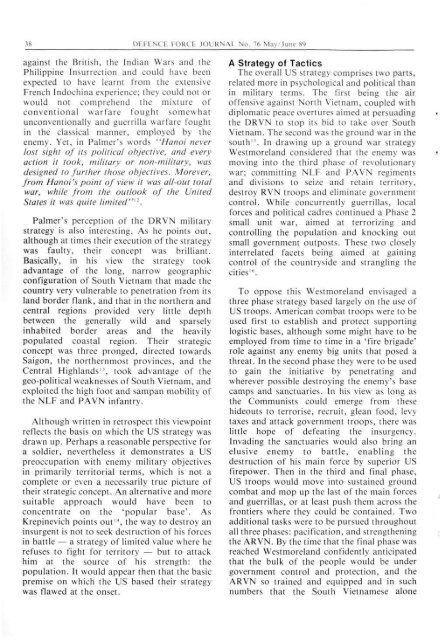ISSUE 76 : May/Jun - 1989 - Australian Defence Force Journal
ISSUE 76 : May/Jun - 1989 - Australian Defence Force Journal
ISSUE 76 : May/Jun - 1989 - Australian Defence Force Journal
- No tags were found...
You also want an ePaper? Increase the reach of your titles
YUMPU automatically turns print PDFs into web optimized ePapers that Google loves.
38 DEFENCE FORCE JOURNAL No. <strong>76</strong> <strong>May</strong>/<strong>Jun</strong>e 89against the British, the Indian Wars and thePhilippine Insurrection and could have beenexpected to have learnt from the extensiveFrench Indochina experience; they could not orwould not comprehend the mixture ofconventional warfare fought somewhatunconventionally and guerrilla warfare foughtin the classical manner, employed by theenemy. Yet, in Palmer's words "Hanoi neverlost sight of its political objective, and everyaction it took, military or non-military, wasdesigned to further those objectives. Morever,from Hanoi's point of view it was all-out totalwar, while from the outlook of the UnitedStates it was quite limited'" 2 .Palmer's perception of the DRVN militarystrategy is also interesting. As he points out,although at times their execution of the strategywas faulty, their concept was brilliant.Basically, in his view the strategy tookadvantage of the long, narrow geographicconfiguration of South Vietnam that made thecountry very vulnerable to penetration from itsland border flank, and that in the northern andcentral regions provided very little depthbetween the generally wild and sparselyinhabited border areas and the heavilypopulated coastal region. Their strategicconcept was three pronged, directed towardsSaigon, the northernmost provinces, and theCentral Highlands", took advantage of thegeo-political weaknesses of South Vietnam, andexploited the high foot and sampan mobility ofthe NLF and PAVN infantry.Although written in retrospect this viewpointreflects the basis on which the US strategy wasdrawn up. Perhaps a reasonable perspective fora soldier, nevertheless it demonstrates a USpreoccupation with enemy military objectivesin primarily territorial terms, which is not acomplete or even a necessarily true picture oftheir strategic concept. An alternative and moresuitable approach would have been toconcentrate on the 'popular base'. AsKrepinevich points out' 4 , the way to destroy aninsurgent is not to seek destruction of his forcesin battle — a strategy of limited value where herefuses to fight for territory — but to attackhim at the source of his strength: thepopulation. It would appear then that the basicpremise on which the US based their strategywas flawed at the onset.A Strategy of TacticsThe overall US strategy comprises two parts,related more in psychological and political thanin military terms. The first being the airoffensive against North Vietnam, coupled withdiplomatic peace overtures aimed at persuading >the DRVN to stop its bid to take over SouthVietnam. The second was the ground war in thesouth' 5 . In drawing up a ground war strategyWestmoreland considered that the enemy was >moving into the third phase of revolutionarywar; committing NLF and PAVN regimentsand divisions to seize and retain territory,destroy RVN troops and eliminate governmentcontrol. While concurrently guerrillas, localforces and political cadres continued a Phase 2small unit war, aimed at terrorizing andcontrolling the population and knocking outsmall government outposts. These two closelyinterrelated facets being aimed at gainingcontrol of the countryside and strangling thecities' 6 .To oppose this Westmoreland envisaged athree phase strategy based largely on the use ofUS troops. American combat troops were to beused first to establish and protect supportinglogistic bases, although some might have to beemployed from time to time in a 'fire brigade'role against any enemy big units that posed athreat. In the second phase they were to be usedto gain the initiative by penetrating andwherever possible destroying the enemy's basecamps and sanctuaries. In his view as long asthe Communists could emerge from thesehideouts to terrorise, recruit, glean food, levytaxes and attack government troops, there waslittle hope of defeating the insurgency.Invading the sanctuaries would also bring anelusive enemy to battle, enabling thedestruction of his main force by superior USfirepower. Then in the third and final phase,US troops would move into sustained groundcombat and mop up the last of the main forcesand guerrillas, or at least push them across thefrontiers where they could be contained. Twoadditional tasks were to be pursued throughoutall three phases: pacification, and strengtheningthe ARVN. By the time that the final phase wasreached Westmoreland confidently anticipatedthat the bulk of the people would be undergovernment control and protection, and theARVN so trained and equipped and in suchnumbers that the South Vietnamese alone
















